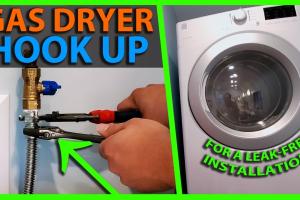Step-by-Step Guide: How to Install a Gas Dryer Like a Pro

-
Quick Links:
- Introduction
- Tools Required
- Pre-Installation Checks
- Installation Steps
- Post-Installation Checklist
- Safety Tips
- Common Issues and Troubleshooting
- Maintenance Tips for Gas Dryers
- Case Studies and Insights
- FAQs
Introduction
Installing a gas dryer can seem daunting, especially if you're not familiar with gas appliances. However, with the right tools and knowledge, you can install your gas dryer safely and efficiently. This guide provides a comprehensive, step-by-step approach to installing a gas dryer, ensuring you have all the information you need to complete the task with confidence.Tools Required
Before you begin, gather the following tools and materials:- Adjustable wrench
- Pipe sealant or Teflon tape
- Dryer venting kit
- Drill and drill bits
- Level
- Screwdriver set
- Safety goggles and gloves
- Measuring tape
- Gas leak detector solution or spray
Pre-Installation Checks
Before diving into the installation, ensure you check the following:- Gas Supply: Verify that you have a natural gas line or propane tank connected to your home.
- Ventilation: Ensure you have proper venting space for your dryer to avoid overheating.
- Dryer Specifications: Read the manufacturer’s manual for specific installation instructions and requirements.
Installation Steps
Follow these steps to install your gas dryer properly:Step 1: Position Your Dryer
Place the dryer where it will be installed, allowing enough space for venting and gas connections.Step 2: Connect the Gas Supply Line
1. Use an adjustable wrench to attach the gas supply line to the dryer. 2. Ensure that you use pipe sealant or Teflon tape on the threads to prevent leaks. 3. Tighten the connection securely.Step 3: Install the Venting System
1. Attach the venting duct to the dryer’s vent outlet. 2. Make sure the duct is as straight as possible with minimal bends. 3. Secure the duct with screws or clamps.Step 4: Level the Dryer
1. Use a level to ensure the dryer is even. 2. Adjust the feet of the dryer as necessary.Step 5: Power On and Test
1. Turn on the gas supply. 2. Use a gas leak detector solution to check for any leaks around the connections. 3. Plug in the dryer and run a test cycle to ensure everything is functioning properly.Post-Installation Checklist
After installing your gas dryer, go through this checklist:- Confirm there are no gas leaks.
- Ensure the venting is secure and unobstructed.
- Check that the dryer is level and stable.
- Run a test load of laundry to confirm proper operation.
Safety Tips
- Always ensure your workspace is well-ventilated. - Never use a gas dryer without proper venting. - Regularly inspect your gas lines and connections for wear and tear. - If unsure about any step, consult a professional.Common Issues and Troubleshooting
If you encounter issues, consider the following: - **Dryer not heating:** Check the gas supply and connections. - **Ventilation issues:** Inspect the duct for blockages. - **Unusual noises:** Ensure the dryer is level and secured.Maintenance Tips for Gas Dryers
To keep your gas dryer running efficiently: - Clean the lint filter before every load. - Inspect the venting system regularly for blockages. - Schedule professional maintenance annually.Case Studies and Insights
**Case Study 1: Homeowner Success Story** Jane, a first-time homeowner, successfully installed her gas dryer by following this guide. She was able to save over $150 in installation fees by doing it herself. Jane’s experience highlights the importance of proper preparation and following safety protocols. **Expert Insight:** According to the American Gas Association, properly installed gas appliances can improve energy efficiency by up to 15%. This not only saves money but also reduces environmental impact.FAQs
1. Can I install a gas dryer myself?
Yes, if you follow safety guidelines and the manufacturer’s instructions. However, consult a professional if you’re unsure.
2. What tools do I need for gas dryer installation?
You will need an adjustable wrench, pipe sealant, a dryer venting kit, and safety gear.
3. How do I check for gas leaks?
Use a gas leak detection solution or spray at the connection points to identify any leaks.
4. What if my dryer won't heat up?
Check that the gas supply is turned on and the connections are secure.
5. How often should I clean the dryer vent?
It’s recommended to clean the vent at least once a year to prevent blockages.
6. Do I need a professional for gas connections?
If you're not comfortable handling gas lines, it’s best to hire a professional.
7. Can I use duct tape for venting?
No, avoid using duct tape as it can degrade over time. Use metal tape or clamps instead.
8. Is it safe to install a gas dryer in a closet?
Yes, as long as there is proper ventilation and space according to the manufacturer’s guidelines.
9. What should I do if my dryer makes strange noises?
Ensure it is level and check for any loose parts or obstructions.
10. Is there a difference between a gas and electric dryer installation?
Yes, gas dryers require gas line connections and proper venting, while electric dryers need a dedicated power outlet.
Random Reads